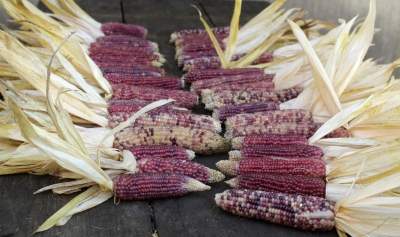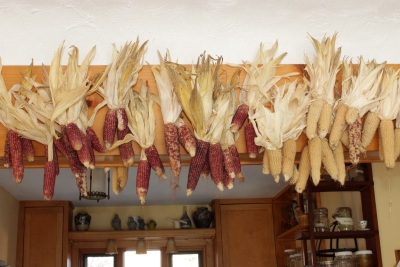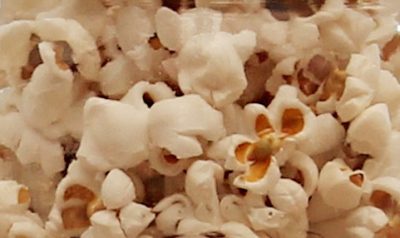COLORFUL EARS, AND TASTY, TOO
Popcorn Traditions
I was surprised at the different colors of my ears this fall — popcorn ears, that is. ‘Pink Pearl’ popcorn lived up to its name, yielding short ears with shiny, pink kernels. Peeling back each dry husk of ‘Pennsylvania Dutch Butter Flavored’ popcorn revealed rows of creamy white kernels. The surprise came from some ears from either bed whose kernels were multi-colored, each in a different way, with some kernels mahogany-red, some pale pink, some dark pink, and some lemon yellow.
I plan to bring some of these popped kernels to Thanksgiving dinner, just as Native American chief Massasoit’s brother, Quadequina, brought along a sack of popped popcorn to the first Thanksgiving feast almost four centuries ago.
Popcorn predates that first Thanksgiving in America by thousands of years. Kernels have been found in the remains of Central American settlements of almost 7000 years ago. The Quichas of Peru and the Aztecs of Mexico grew red, yellow, and white popcorns. Even after that first Thanksgiving dinner, popcorn was eaten by settlers in the Northeast as a breakfast staple with milk and maple sugar, or floated on soup (very good!). Beginning in the last century, movie and television viewing caused a resurgence in popcorn consumption.
Is It Worth Growing?
I can just hear some “rational” person explaining to me why popcorn isn’t worth growing in a backyard garden. After all, you can pick up a whole pound of popcorn for couple of dollars from a supermarket shelf. And not just any popcorn, but “gourmet” popcorn that makes tender and large (expansion ratio of forty-four to one, for the technically-minded) popped kernels.
If you buy popcorn, you also don’t have to set aside a separate portion of the garden for it. Popcorn has to be isolated from sweet corn or else cross-pollination between the plants will make popcorn less poppable and sweet corn less sweet. In my garden, a distance of about fifty feet has been enough to keep popcorn and sweet corn to themselves. (I have two vegetable gardens, affectionately and jokingly referred to as le potager du nord and potager du sud.)
Likewise, if you want each kernel of Pennsyvania Dutch Butter Flavored popcorn to be white and each one of Pink Pearl to be pink, you need to isolate these varieties from each other. My surprise ears arose, no doubt, from the insufficient isolation of the two varieties from each other. Depending on where they are in the rotation of beds in le potager du sud, the two varieties might be as close as eight feet or as far a twenty five feet apart.
Another rationale against growing backyard popcorn is the trouble of weeding and keeping pests at bay. I did weed, but there were no pest problems.
And then, if you grow popcorn, you have to go to the trouble of harvesting the ears and preparing the kernels for popping. On a dry, sunny day back in October, I went out to the garden and snapped each ear off its stalk. I sat down on an overturned crate next to my basketful of popcorn ears, and as the autumn sun warmed my shoulders, I pulled back the dry husks to expose the ears, then tied them together in bundles by their husks. All this “trouble” was not what I would call unpleasant activity. Most of the bundles now are hanging – and decorating – a rafter in my kitchen.
To ready the corn for popping, I snap a few kernels off an ear to make some empty space, then grasp the ear in both hands and twist it the way friends and I used to give what was then called “Indian burns” on each others’ wrists in my youth.
Popping Now, and Planning for Next Year
When it comes to actually popping the corn, you can have confidence that almost every kernel of store-bought popcorn will pop. Water — just the right amount (13 to 14.5%, once again, for the technically-minded) — is the secret to getting popcorn to pop. I’ve heard of gardeners trying to get their harvested popcorn to the right moisture level by either sprinkling the kernels with water or by spreading the kernels on trays to dry in the sun. An old gardening book recommends letting popcorn “dry in a loft for a season or two. Dry two-year-old corn pops best.”[!] I couldn’t confirm that because each season’s harvest is pretty much eaten when the next batch is ready to store here.
Don’t let fear of non-popping dissuade you from planting popcorn next May. 
By leaving ears on the stalks until fully ripe, then hanging them in a dry location indoors (my kitchen), my popcorn’s poppability (percent of kernels popping) almost matches that of store-bought.
I admit that my popcorns’ expansion ratios are only a measly twenty to one, but this ratio depends more on what variety is grown than on horticultural skill.
Taste differences between popcorns are more significant, and I believe that my popcorn tastes better than store-bought, richer and “cornier”. I once thought that this was perhaps an example of the “halo” effect, in this case my growing the popcorn makes me believe it tastes better than the bought stuff. But a few years ago a neighbor grew his own popcorn and volunteered that he agreed. (Two “halo” effects. Perhaps. Try a blind tasting.)
All winter, whenever I pop popcorn, I drop a few seeds from each ear into an envelope, a separate one for each variety to provide seed for the next season’s garden. Collecting a few seeds from many plants, according to Carol Deppe’s excellent book Breed Your Own Vegetables, prevents inbreeding depression that corn, which can self-pollinate, is very subject to. Inbreeding depression leads to, as Carol writes, plants that “germinate poorly, grow poorly, yield poorly, and die (or yield nothing at all) at the slightest excuse.”
All in all, it seems to me that the main rationale against growing popcorn is having to decide whether to eat or to admire the colorful ears hanging from the kitchen rafter.
Have a happy Thanksgiving.




Could the ears of popcorn be hung in an unheated garage?
Yes, that would work, although they’d probably need to hang a little longer that if indoors so that they dried down sufficiently for good popping.